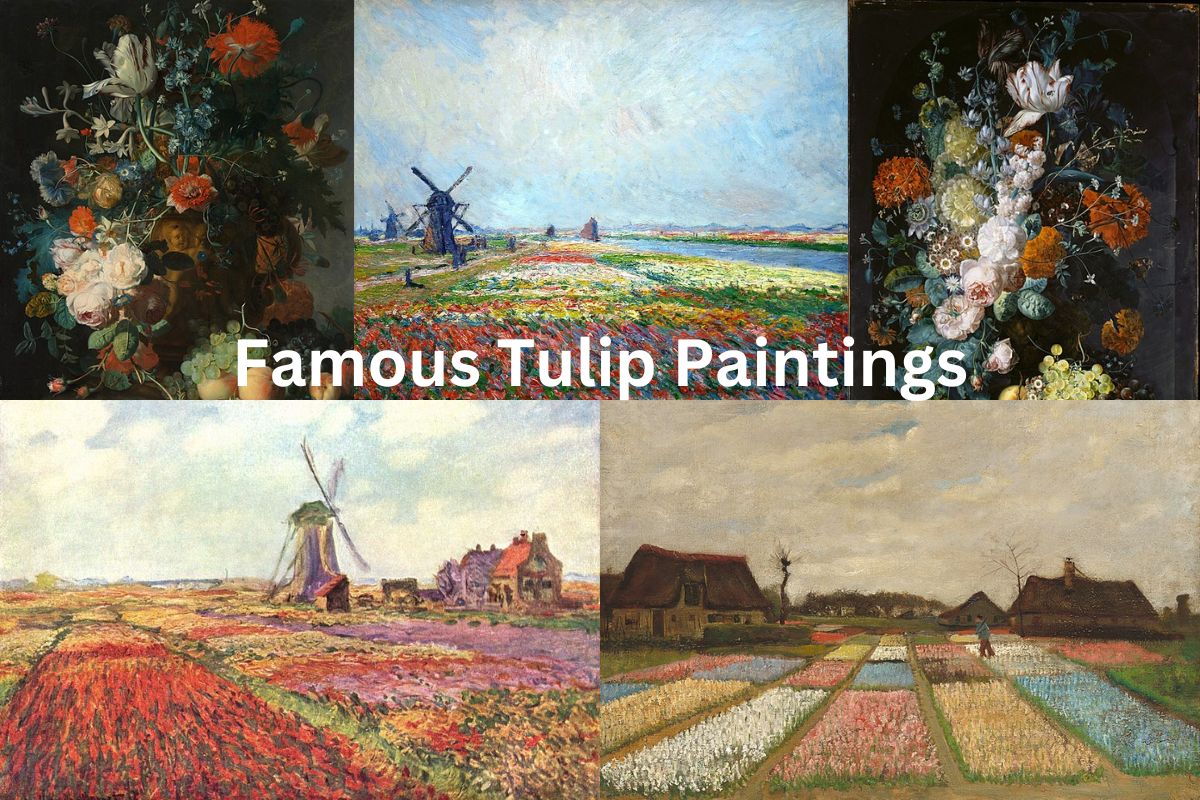Tulips have been a popular subject of paintings for centuries, capturing their vibrant colors and delicate beauty.
The history of tulip paintings can be traced back to the early 17th century when Dutch artists began incorporating them into their still-life paintings.
During the Dutch Golden Age, tulips became a symbol of wealth and status, and their beauty was celebrated through art.
The tulip trade also became a booming industry in the Netherlands, with bulbs selling for exorbitant prices during the Tulipomania period.
Famous Tulip Paintings
1. Bulb Fields – Vincent van Gogh
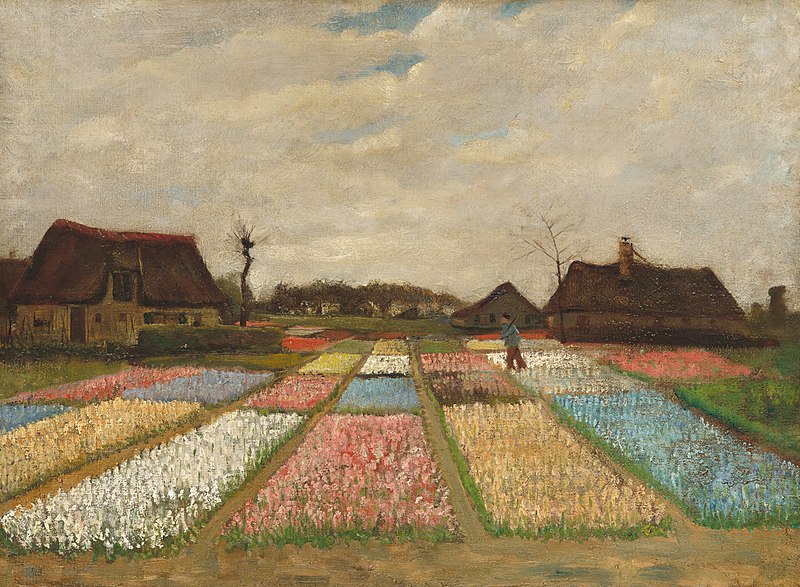
Bulb Fields, also known as Flower Beds in Holland, is an oil work by Vincent van Gogh that was completed in early 1883. In 1983, it was given to the National Gallery of Art in Washington, DC.
Van Gogh’s first garden painting, Bulb Fields, was done in oil paint on canvas mounted on wood. Van Gogh created it during his second year in The Hague.
It displays a Dutch bulb merchant’s rectangular plots of blue, yellow, pink, and scarlet hyacinths.
The low vantage point provides a panoramic view of the field of beautiful spring flowers, which is framed by thatched huts and leafless trees.
Van Gogh can explore his fascination in perspective because to the regular composition.
2. Tulips in Holland – Claude Monet
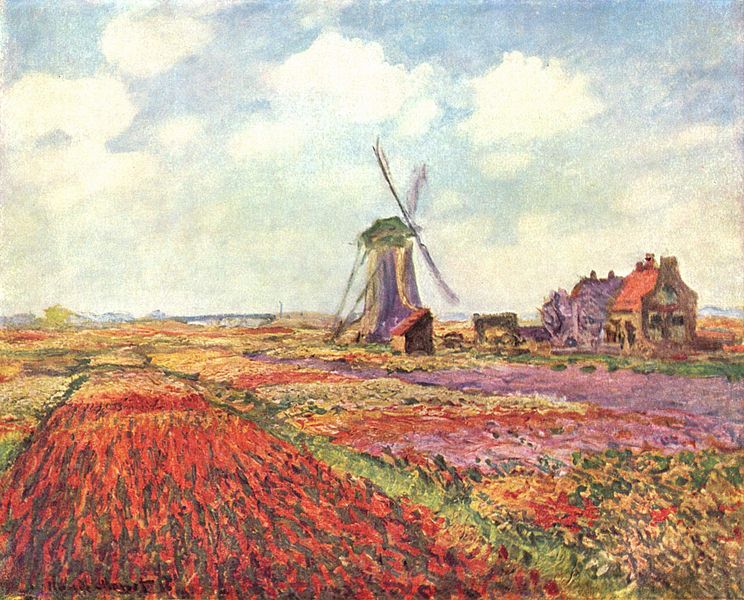
Claude Monet’s “Tulips in Holland” is a beautiful landscape painting that depicts a field of colorful tulips in the foreground, with a windmill in the background.
The painting was created during Monet’s visit to the Netherlands in 1886, where he was struck by the beauty of the tulip fields.
In “Tulips in Holland,” Monet uses his signature Impressionist style, characterized by loose brushstrokes and vibrant colors, to capture the beauty of the flowers.
The tulips are depicted in shades of pink, red, and white, with the sunlight creating a warm glow.
The painting is notable for its use of light and shadow, which creates a sense of depth and dimensionality. The bright colors of the tulips are contrasted with the darker shadows in the foreground, which helps to create a sense of perspective and space.
Monet was known for his love of nature and his ability to capture the changing light and atmosphere of the landscape. “Tulips in Holland” is a beautiful example of his skill as a painter, capturing the beauty of the Dutch countryside in springtime and the vibrant colors of the tulips.
3. Tulip Fields near The Hague – Claude Monet
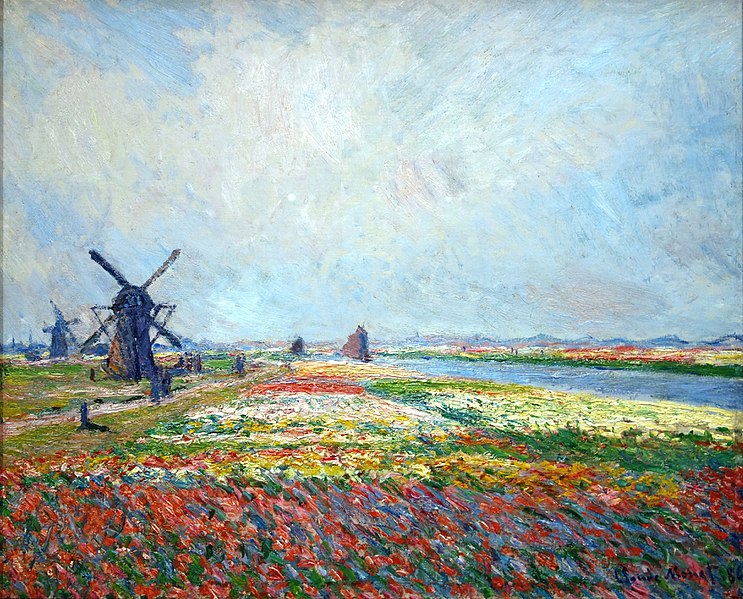
The vibrantly colored bulb fields of Holland captivated Claude Monet. He wrote to a friend in the early spring of 1886 that the sight was “difficult to depict with our lousy hues.”
Monet had traveled to the Netherlands before, but this was his first time painting the sea of flowers.
After he returned to Paris, he sold the painting to art dealer Boussod, Valadon & Cie, where Theo van Gogh worked. It’s probable that his brother Vincent witnessed it. Vincent gradually grew to appreciate Monet’s quick brushstrokes and vibrant colors.
4. Tulips in a Vase – Hans Gillisz. Bollongier
“Tulips in a Vase” is a painting by Hans Gillisz. Bollongier, a Dutch Golden Age artist known for his still-life paintings featuring flowers. The painting depicts a vase filled with a colorful bouquet of tulips, arranged in a way that emphasizes the different shapes and colors of each flower.
Bollongier’s painting is notable for its use of light and shadow to create a sense of depth and dimensionality. The tulips are painted with a range of vibrant colors, including red, pink, yellow, and white, and their petals are rendered with great detail and texture.
The vase itself is also painted with intricate patterns and delicate brushstrokes, adding to the overall sense of realism in the painting.
The tulip was a popular subject of still-life paintings during the Dutch Golden Age, and “Tulips in a Vase” is a beautiful example of this tradition.
Bollongier’s use of color and composition creates a sense of harmony and balance in the painting, drawing the viewer’s eye to the intricate details of each flower and the vase that holds them.
Today, “Tulips in a Vase” is part of the permanent collection at the Rijksmuseum in Amsterdam, where it is admired for its beauty and its importance as a work of Dutch Golden Age art.
It is a testament to Bollongier’s skill as a painter and his ability to capture the beauty of the world around him.
5. Still-Life with Flowers – Ambrosius Bosschaert the Elder
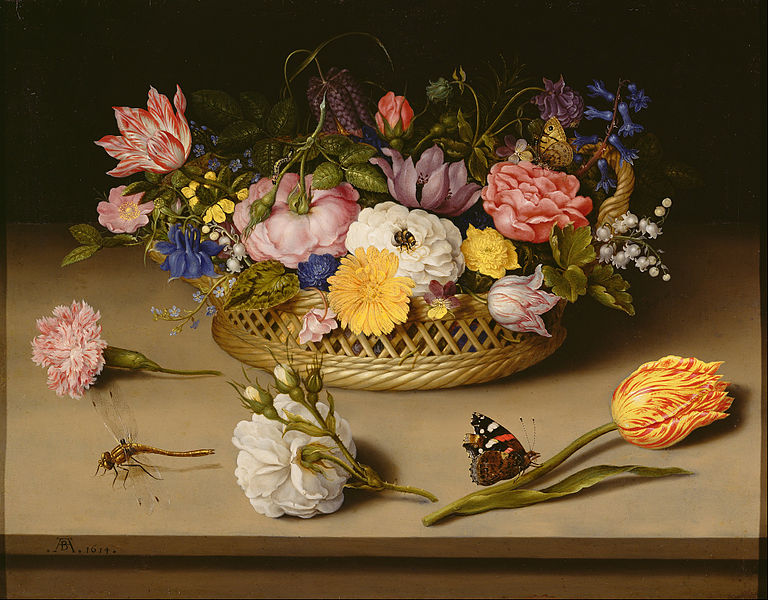
“Still-Life with Flowers” is a stunning painting by Ambrosius Bosschaert the Elder, a Dutch still-life painter of the early 17th century. The painting depicts a flat vase filled with a beautiful bouquet of flowers, surrounded by several other flowers and leaves.
Bosschaert’s painting is remarkable for its incredible attention to detail and realism. The bouquet in the vase is composed of different types of flowers, including roses, tulips, and lilies, and each flower is painted with great care and accuracy.
The colors of the flowers are also meticulously arranged, creating a sense of harmony and balance in the painting.
Bosschaert was a master of the still-life genre, and “Still-Life with Flowers” is one of his most celebrated works. It exemplifies the Dutch Golden Age tradition of still-life painting, which focused on the beauty and symbolism of everyday objects.
Today, the painting is part of the permanent collection at the National Gallery in London, where it is admired for its beauty and its importance as a work of art.
6. Stilleven met bloemen – Jan van Huysum
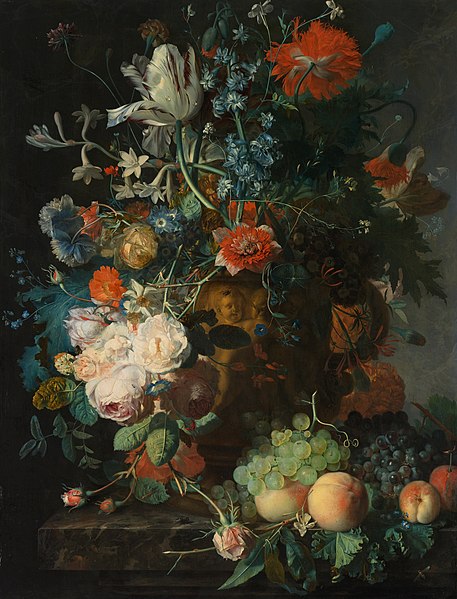
“Stilleven met bloemen” (Still Life with Flowers) is a stunning painting by Jan van Huysum, a Dutch Golden Age painter known for his elaborate still-life paintings. The painting features a bouquet of colorful flowers arranged in a vase, with various insects and small animals surrounding them.
Van Huysum’s painting is known for its incredible attention to detail and realism. The flowers in the bouquet are rendered with great accuracy, with each petal and leaf carefully painted to create a sense of movement and texture. The colors of the flowers are also carefully chosen and arranged to create a harmonious composition.
The vase in the painting is equally remarkable, with intricate patterns and delicate brushstrokes creating a sense of depth and texture.
The small animals and insects surrounding the flowers, including butterflies and snails, add to the overall sense of realism and create a sense of the natural world.
“Stilleven met bloemen” is considered one of Van Huysum’s most celebrated works and is regarded as one of the finest examples of Dutch still-life painting. The painting is part of the permanent collection at the Rijksmuseum in Amsterdam, where it is admired for its beauty and its importance as a work of Dutch Golden Age art.
7. Bouquet of Flowers in a Stone Niche – Ambrosius Bosschaert the Elder
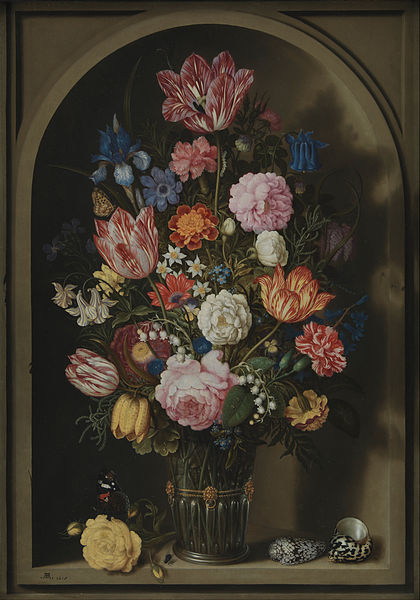
“Bouquet of Flowers in a Stone Niche” is a stunning painting by Ambrosius Bosschaert the Elder, a Dutch Golden Age artist known for his elaborate still-life paintings. The painting features a beautiful bouquet of flowers arranged in a stone niche, with intricate details and a realistic perspective.
Bosschaert’s painting is notable for its incredible attention to detail and its realistic portrayal of the flowers.
The bouquet in the niche is composed of different types of flowers, including tulips, roses, lilies, and carnations, and each flower is painted with great care and precision. The colors of the flowers are also carefully arranged, creating a sense of harmony and balance in the painting.
The stone niche itself is equally remarkable, with intricate details and realistic textures that add to the overall sense of realism in the painting. The use of light and shadow also creates a sense of depth and dimensionality, adding to the illusion that the flowers are actually in a stone niche.
“Bouquet of Flowers in a Stone Niche” is a testament to Bosschaert’s skill as a still-life painter and his ability to capture the beauty of the natural world. The painting is part of the permanent collection at the J. Paul Getty Museum in Los Angeles, where it is admired for its beauty and its importance as a work of Dutch Golden Age art.
8. A Vase of Flowers – Margaretha Haverman
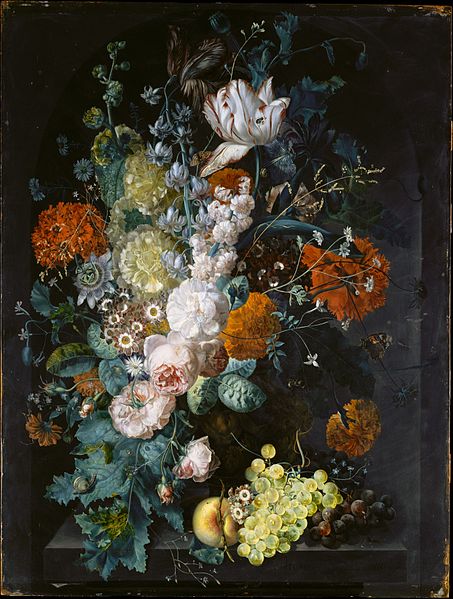
A Vase of Flowers was painted by the Dutch artist Margaretha Haverman in 1716. It is part of the Metropolitan Museum of Art’s collection.
The artwork depicts rosa centifolia, dianthus, alcea rosea, calendula officinalis, passiflora, primula, poppy, tulip, forget-me-nots, peach and grape fruits, and various invertebrates including a Red Admiral butterfly, a fly, ants, and a snail. The vase itself is a baroque relief-adorned object.
Following the Dutch and Flemish flower still life tradition, the painting depicts flowers in a container with insects.
This was prevalent among Dutch women painters during Haverman’s lifetime, whose works she would have known.
The painting depicts the model from which the ladies drew, as well as the superiority of Ruysch’s work over Elliger’s later in the 18th century.
Haverman was registered as a student of the flower painter Jan van Huysum, who was notorious for protecting his secrets and keeping his painting expertise within the family. This work demonstrates Van Huysum’s influence in its “niche” context.
9. The Vase of Tulips – Paul Cezanne
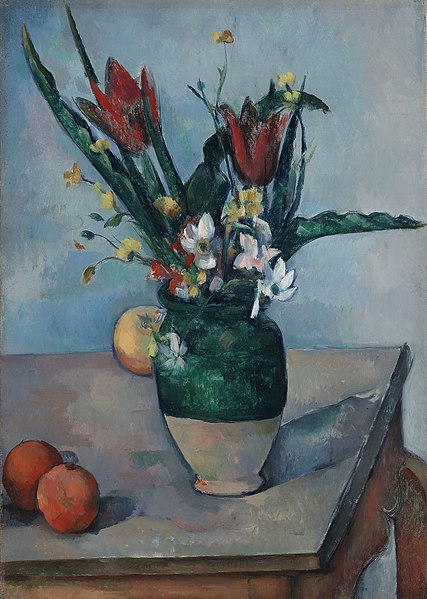
“The Vase of Tulips” is a painting by Paul Cezanne, a French Post-Impressionist painter known for his innovative approach to composition and color. The painting features a bouquet of tulips arranged in a vase, with a simple background that emphasizes the beauty of the flowers.
Cezanne’s painting is notable for its use of color and form to create a sense of depth and perspective. The tulips in the bouquet are painted with a range of vibrant colors, including red, yellow, and pink, and their petals are rendered with great detail and texture.
The vase is also painted with intricate patterns and delicate brushstrokes, creating a sense of texture and depth.
The background of the painting is deliberately simple, with a plain blue background that emphasizes the beauty of the flowers.
Cezanne’s use of color and form creates a sense of harmony and balance in the painting, drawing the viewer’s eye to the intricate details of the flowers and the vase that holds them.
10. De vroege Brabantsson – Judith Leyster
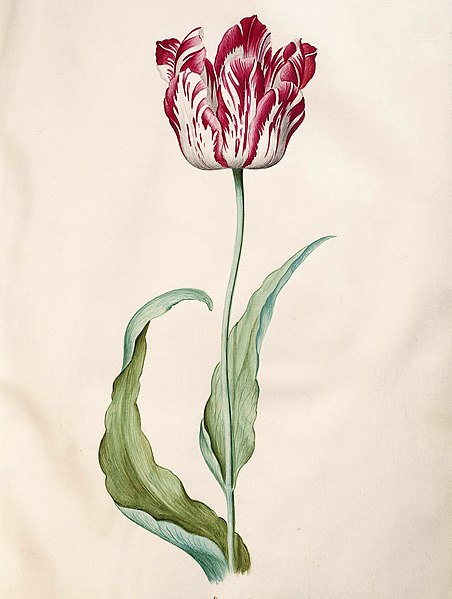
The Early Brabantsson is an 18th-century watercolour by Judith Leyster. It is one of her final documented works. It depicts a skillfully rendered tulip of a variety that produced capitals during the tulpomania of 1637.
At the start of her career, she primarily painted genre works, but after her marriage in 1636, only a still life, a flower arrangement, a self-portrait, and this one watercolor are known to exist.
Since the 1993 retrospective, another watercolor of a similar bloom, which according to the inscription would also be hers, has not been attributed to her.
The watercolor is created on a sheet of parchment that was bound with other watercolors in the eighteenth century into the Frans Hals Museum’s Tulip Book.
These tulip books are also known from the seventeenth century and consisted of bonded groups of watercolors depicting only tulips. These publications were compiled by plant enthusiasts and farmers.

